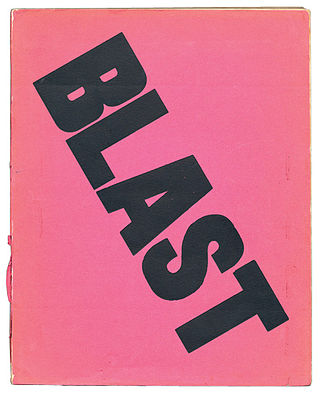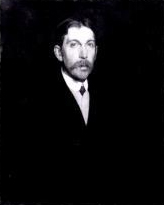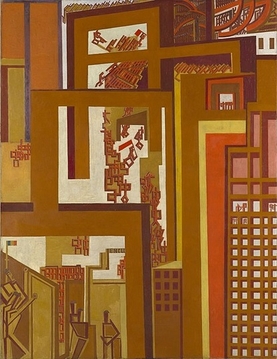
Percy Wyndham Lewis was a British writer, painter and critic. He was a co-founder of the Vorticist movement in art and edited BLAST, the literary magazine of the Vorticists.

Vorticism was a London-based modernist art movement formed in 1914 by the writer and artist Wyndham Lewis. The movement was partially inspired by Cubism and was introduced to the public by means of the publication of the Vorticist manifesto in Blast magazine. Familiar forms of representational art were rejected in favour of a geometric style that tended towards a hard-edged abstraction. Lewis proved unable to harness the talents of his disparate group of avant-garde artists; however, for a brief period Vorticism proved to be an exciting intervention and an artistic riposte to Marinetti's Futurism and the post-impressionism of Roger Fry's Omega Workshops.

Roger Eliot Fry was an English painter and critic, and a member of the Bloomsbury Group. Establishing his reputation as a scholar of the Old Masters, he became an advocate of more recent developments in French painting, to which he gave the name Post-Impressionism. He was the first figure to raise public awareness of modern art in Britain, and emphasised the formal properties of paintings over the "associated ideas" conjured in the viewer by their representational content. He was described by the art historian Kenneth Clark as "incomparably the greatest influence on taste since Ruskin ... In so far as taste can be changed by one man, it was changed by Roger Fry". The taste Fry influenced was primarily that of the Anglophone world, and his success lay largely in alerting an educated public to a compelling version of recent artistic developments of the Parisian avant-garde.

Blast was the short-lived literary magazine of the Vorticist movement in Britain. Two editions were published: the first on 2 July 1914 and featured a bright pink cover, referred to by Ezra Pound as the "great MAGENTA cover'd opusculus"; and the second a year later on 15 July 1915. Both editions were written primarily by Wyndham Lewis. The magazine is emblematic of the modern art movement in England, and recognised as a seminal text of pre-war 20th-century modernism. The magazine originally cost 2/6.

Christopher Richard Wynne Nevinson was an English figure and landscape painter, etcher and lithographer, who was one of the most famous war artists of World War I. He is often referred to by his initials C. R. W. Nevinson, and was also known as Richard.

Sir William Rothenstein was an English painter, printmaker, draughtsman, lecturer, and writer on art. Though he covered many subjects – ranging from landscapes in France to representations of Jewish synagogues in London – he is perhaps best known for his work as a war artist in both world wars, his portraits, and his popular memoirs, written in the 1930s. More than two hundred of Rothenstein's portraits of famous people can be found in the National Portrait Gallery collection. The Tate Gallery also holds a large collection of his paintings, prints and drawings. Rothenstein served as Principal at the Royal College of Art from 1920 to 1935. He was knighted in 1931 for his services to art. In March 2015 'From Bradford to Benares: the Art of Sir William Rothenstein', the first major exhibition of Rothenstein's work for over forty years, opened at Bradford's Cartwright Hall Gallery, touring to the Ben Uri in London later that year.

Michael Ayrton was a British artist and writer, renowned as a painter, printmaker, sculptor and designer, and also as a critic, broadcaster and novelist. His sculptures, illustrations, poems and stories often focused on the subjects of flight, myths, mirrors and mazes.

Edward Alexander Wadsworth was a British artist initially associated with the Vorticism movement. In the First World War he was part of a team involved in the transfer of dazzle camouflage designs to ships for the Royal Navy. After the war his maritime landscapes and still-life compositions using tempera were infused with a surrealistic mood - although he never exhibited with the British surrealists. In the early thirties and in the early forties his work was mainly abstract. He made a significant contribution to the development of modern art in Britain in the inter-war years.

Jessica Stewart Dismorr was an English painter and illustrator. Dismorr participated in almost all of the avant-garde groups active in London between 1912 and 1937 and was one of the few English painters of the 1930s to work in a completely abstract manner. She was one of only two women members of the Vorticist movement and also exhibited with the Allied Artists Association, the Seven and Five Society and the London Group. She was the only female contributor to Group X and displayed abstract works at the 1937 Artists' International Association exhibition. Poems and illustrations by Dismorr appeared in several avant-garde publications including Blast, Rhythm and an edition of Axis.
Helen Saunders was an English painter associated with the Vorticist movement.

Rosa Winifred Nicholson was a British painter. She was married to the painter Ben Nicholson, and was thus the daughter-in-law of the painter William Nicholson and his wife, the painter Mabel Pryde. She was the mother of the painter Kate Nicholson.
Arthur Lett-Haines, known as Lett Haines, was a British painter and sculptor who experimented in many different media, though he generally characterised himself as "an English surrealist". He was part of a London artistic circle, which included D. H. Lawrence, the Sitwells and Wyndham Lewis, but for most of his life lived with the painter and gardener Cedric Morris in Cornwall, Paris and finally Suffolk.

Francis Vane Phipson Rutter was a British art critic, curator and activist.
Unit One was a British grouping of Modernist artists founded by Paul Nash. The group included painters, sculptors and architects, and was active from 1933 to 1935. It held one exhibition, which began at the Mayor Gallery in Cork Street, London, and then went on an extended tour, closing in Belfast in 1935. The artists planned the group at meetings held at the Mayor Gallery; Paul Nash announced its creation in a letter to The Times on 12 June 1933. A book by Herbert Read, Unit One: the modern movement in English painting, sculpture, and architecture, was published at the time of the exhibition. Despite its brief period of activity, the group is regarded as influential in establishing the pre-eminence of London as a centre of modernist and abstract art and architecture in the mid-1930s.

Edward McKnight Kauffer was an American artist and graphic designer who lived for much of his life in the United Kingdom. He worked mainly in poster art, but was also active as a painter, book illustrator and theatre designer.

Cuthbert Hamilton (1885–1959) was a British artist associated with the Vorticist movement and later with Group X. He was one of the pioneers of abstract art in Britain.
The Archdeacon of Coventry is a senior ecclesiastical officer in the Church of England Diocese of Coventry. The post has been called the Archdeacon Pastor since 2012.

Edward Armstrong was an English historian.

Mary Constance Charteris, Countess of Wemyss and March, styled Lady Elcho from 1883 to 1914, was an English society hostess and an original member of The Souls, an exclusive social and intellectual group.

The Crowd is a 1914–1915 abstract painting by the English artist Wyndham Lewis. It is an example of Vorticism, a modern art movement Lewis created. It was first exhibited in March 1915 with The London Group. At one point, it was known as Revolution, due to a misunderstanding that it was inspired by the 1917 October Revolution in Russia. Since 1964, it is in the collection of Tate in London.

















